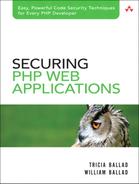In this chapter, we cover a special type of injection attack called cross-site scripting, or XSS. This is a special type of code injection attack (remember those from Chapter 5, “Input Validation”?) that doesn’t affect your system as much as it affects your users. Our example guestbook is exactly the type of site that is vulnerable to these attacks.
XSS is just a special case of code injection. In this type of attack, the malicious user embeds HTML or other client-side script into your Web site. The attack looks like it is coming from your Web site, which the user trusts. This enables the attacker to bypass a lot of the client’s security, gain sensitive information from the user, or deliver a malicious application. There are two types of XSS attacks:
• Reflected or nonpersistent
• Stored or persistent
This is the most common type of XSS and the easiest for a malicious attacker to pull off. The attacker uses social engineering techniques to get a user to click on a link to your site. The link has malicious code embedded in it. Your site then redisplays the attack, and the user’s browser parses it as if it were from a trusted site. This method can be used to deliver a virus or malformed cookie (used to hijack sessions later) or grab data from the user’s system. One famous example of this was found in Google’s search results. The malicious code would be tacked onto the end of a search link. When the user clicked on the link, the code would get displayed as part of the search string. The user’s browser would parse this and compromise his or her system.
Defend against this as you would any variable injection attack. Before you display any user-generated data, validate the input. Do not trust anything that the user’s browser sends you.
This is a less common but far more devastating type of attack. One instance of a stored XSS attack can affect any number of users. This type of attack happens when users are allowed to input data that will get redisplayed, such as a message board, guestbook, etc. Malicious users put HTML or client-side code inside their post. This code is then stored in your application like any other post. Every time that data is accessed, a user has the potential to be compromised. Most of the time this is a link that still requires social engineering to compromise your users, but more sophisticated attackers will launch attacks without the user doing any more than loading your page.
This is all scary stuff, but the defense is the same: If you allow user input, validate it before you store it in your application.
There are two ways we can handle patching our application. One is far easier and more secure but gives the user less flexibility. The other method allows a much wider range of user input but is much harder to implement securely. Once again, we have to weigh the usability of our application against security concerns.
We have decided that we don’t really need fancy posts in our guestbook so we will go the easier, more secure route. We will simply disallow HTML and all scripting in any user input (name, message, etc.) field. Any input that contains scripting code will be discarded with an error message. Just to be on the safe side, we will also escape all special characters such as ( and < to their HTML entities. Luckily for us, our sanitation API already does this, and we are already passing our variables through the sanitizer. In patching the application to sanitize all user input variables, we actually closed two potential security holes—general variable injection and XSS.
The fix gets a lot trickier if you want to allow scripts and HTML to be embedded in user inputs. There are two ways to do this, both of which are a little beyond the scope of this book and our application. You could discard any user-inputted code and allow HTML only via buttons on your page, giving the user a very limited set of code elements to use. You still have to validate the user input, because even limiting the user to a predefined subset of HTML isn’t foolproof. A sophisticated attacker can get around this precaution by nesting malicious code within the allowed HTML. If you allow users to include links in their posts, there is no way to defend against XSS—unless you personally have the time to manually check each and every link a user posts.
There is one more option: You can create filters that try to validate user input and filter out the malicious code while keeping the good input. This involves a rather tricky set of regular expressions that are well beyond the scope of this book. Luckily, there are some open-source projects already taking on this task. None of them are completely foolproof, because by the time a filter is created to identify one type of malicious code, several others have been created. Filters do have their place, as long as you realize that they aren’t a guarantee of security. If you decide to try to filter out malicious code from user input, we suggest looking into the following projects:
• OWASP’s PHP filters: www.owasp.org/index.php/OWASP_PHP_Filters. This project includes filters for all types of attacks.
• PHP IDS: http://php-ids.org. This is an intrusion detection system with the capability to report the types of attacks to you, but you need to configure how the system will respond to various circumstances.
• htmLawed: www.bioinformatics.org/phplabware/
internal_utilities/htmLawed/index.php. This is an open-source PHP HTML filter.
• HTML Purifier: http://htmlpurifier.org/. This filter implements a whitelist approach to PHP filtering.
